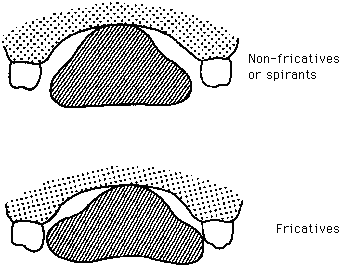Remember
If the airstream is partially or totally blocked, the sound produced is a consonant. That's what distinguishes consonants from vowels.
There are two distinct types of consonant:
-
when the passage of air is fully blocked, and the sound results from the sudden release of this blockage: the "plosives";
-
when the passage of air is restricted but not fully stopped: the continuants, of which the fricatives are representative.
Plosives
The plosives require a complete closure of the speech canal, not just a restriction. This distinguishes them from the continuants.
The occlusion is twofold:
- the airstream is halted by a sudden closure in the speech canal;
- the trapped air is freed by abruptly releasing the closure.
Fricatives
Fricative consonants result from a narrowing of the speech canal that does not achieve the full closure characteristic of the occlusives. The shape and position of the lips and/or tongue determine the type of fricative produced.
We distinguish below between so-called true fricatives and the related class of spirants.
During the production of a fricative, the airstream can be directed in several ways:
-
the tongue channels the air through the center of the mouth in the case of the dorsal fricatives, described below under true fricatives (see left side of figure 3.13 below);
-
the tongue channels the air down the side(s) of the mouth in the case of the lateral fricatives (see right side of figure 3.13 below);
-
the shape and position of the tongue is not important in the case of the labial and dental fricatives (which makes sense because the place of articulation is not, strictly speaking, in the oral cavity at all); these are listed among the true fricatives and the spirants below; their special status is noted in each case.
Laterals
Laterals are generally considered to be a special case, since physically speaking they could be grouped among the fricatives and spirants.
They are called laterals since, during their production, the back of the tongue makes contact with the hard palate while the front of the tongue sinks down, channeling the air laterally around the tongue, down the side (or sometimes both sides) of the mouth (see figure 3.25 below). (On the other hand, for non-lateral articulations, the back of the tongue rests against the top molars, and the air flows over the tongue down the center of the mouth.)

Figure 3.25 : position of the tongue in lateral fricatives and spirants
There are two distinct types of lateral:
-
Lateral fricatives, where the articulation, requiring a great deal of muscular tension, resembles that of the fricatives (except for the position of the tongue);
-
Non-fricative lateral, often called liquids, whose articulation is very close to the spirants'.
The location of the lateral channel through which the air flows is unimportant: whether it is on the left, the right, or both sides of the mouth, the nature of the sound produced is unchanged.
Vibrants
These consonants involve one or more tapping or flapping vibrations of the speech organs under pressure from the airstream. Part of the tongue makes contact with the palate, most commonly at the alveolar ridge, the soft palate, or the uvula. One or more very brief occlusions occur successively, accompanied by short resonances. Vibrants are generally voiced. A small subscript circle may be added to any of the symbols below (and to any IPA symbol in general) to indicate a voiceless variant.
There are two distinct classes of vibrant:
- those with only one vibration, called taps;
- those with multiple vibrations, called trills.
